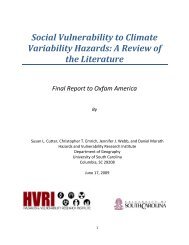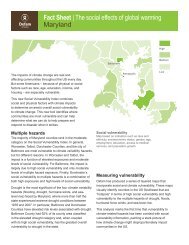Poverty Footprint Study on how the Coca Cola - Oxfam America
Poverty Footprint Study on how the Coca Cola - Oxfam America
Poverty Footprint Study on how the Coca Cola - Oxfam America
Create successful ePaper yourself
Turn your PDF publications into a flip-book with our unique Google optimized e-Paper software.
employment include some workers in <strong>the</strong> sugar fields,<br />
some workers in distributi<strong>on</strong> (e.g. minibodegas) and<br />
retail channels (e.g. workers in street kiosks) and<br />
workers in some of <strong>the</strong> smallholders sugarcane farms.<br />
These jobs are unregulated but represent essential<br />
lifelines for vulnerable people.<br />
A worker’s livelihood and job security depend <strong>on</strong><br />
whe<strong>the</strong>r a job is located in <strong>the</strong> formal or informal sector.<br />
Workers in <strong>the</strong> formal sector can claim entitlements<br />
from <strong>the</strong>ir employer and social welfare benefits from <strong>the</strong><br />
government.<br />
They can also more easily engage in collective<br />
negotiati<strong>on</strong>s and enjoy a measure of security against<br />
arbitrary dismissal.<br />
Workers in <strong>the</strong> informal sector, by c<strong>on</strong>trast, typically<br />
enjoy fewer rights, may endure substandard working<br />
c<strong>on</strong>diti<strong>on</strong>s, receive limited or no social security and are<br />
particularly vulnerable to fluctuati<strong>on</strong>s in <strong>the</strong> market.<br />
Never<strong>the</strong>less, for those at <strong>the</strong> edge of survival, informal<br />
work is often preferable to no work at all.<br />
Figure 10: Sources<br />
1 Source: 20 workers surveyed<br />
2 Source: 9 Producers surveyed<br />
3 Source: 6 workers from Izalco, 3 from El Angel surveyed<br />
4 Source: 8 ILC employees out of 14 surveyed<br />
5 Source: 6 Owners surveyed. Income from all sources, not just from <strong>Coca</strong>-<strong>Cola</strong> products<br />
6 Source: Data from 95 stores<br />
7 Source: 14 full-time salaried employees surveyed<br />
8<br />
9<br />
10<br />
11<br />
12<br />
<strong>Oxfam</strong>, am<strong>on</strong>g o<strong>the</strong>rs, has proposed <strong>the</strong> c<strong>on</strong>cept of<br />
a “living wage” as a useful platform for needed wage<br />
improvements. <strong>Oxfam</strong> defines a living wage as a net<br />
wage earned for a full-time working week (without<br />
overtime), which allows a family to meet its basic<br />
needs and allows a small amount for discreti<strong>on</strong>ary<br />
spending. These needs include nutriti<strong>on</strong>, clothing,<br />
health care, educati<strong>on</strong>, drinking water, child care,<br />
transportati<strong>on</strong>, housing, vacati<strong>on</strong> and energy,<br />
in additi<strong>on</strong> to a small amount for discreti<strong>on</strong>ary<br />
spending, savings and investments.<br />
Source: World Bank PovcalNet Available at http://iresearch.worldbank.org/PovcalNet/povcalNet.<br />
html c<strong>on</strong>verted to 2009 Prices using USDA Ec<strong>on</strong>omic Research Service GDP Deflators<br />
Source: Romero Pineda & Asociados Reported Minimum Wages (2009) Available at http://<br />
www.romeropineda.com/downloads/New_Minimun_Wages.pdf<br />
Source: Romero Pineda & Asociados Reported Minimum Wages (2009) Available at http://<br />
www.romeropineda.com/downloads/New_Minimun_Wages.pdf<br />
Source: Canasta Básica Alimentaria, Encuesta de Hogares de<br />
Propósitos Múltiples 2009 Available at http://www.digestyc.gob.sv/publicaci<strong>on</strong>es/EHPM2009.pdf<br />
Source: Canasta Básica Alimentaria, Encuesta de Hogares de<br />
Propósitos Múltiples 2009 Available at http://www.digestyc.gob.sv/publicaci<strong>on</strong>es/EHPM2009.pdf<br />
Minimum wages, living wages and benefits<br />
Minimum wages should act as a critical safety net,<br />
ensuring that wages are sufficient to meet people’s<br />
basic needs. While it is difficult to obtain credible<br />
estimates of what it would cost to cover <strong>the</strong> basic<br />
needs of an average family, it is clear that most current<br />
minimum wage standards are insufficient. For example,<br />
in Zambia, <strong>the</strong> minimum wage was established in<br />
1994 and has not been adjusted, although Zambia has<br />
experienced annual inflati<strong>on</strong> rates of up to 21 percent<br />
since this time. 53<br />
At present, a credible study of what would c<strong>on</strong>stitute<br />
a living wage in ei<strong>the</strong>r Zambia or El Salvador is<br />
not available. There are few indicators that could<br />
approximate a living wage in both countries since<br />
most indicators that measure basic needs of an<br />
average family in developing countries tend to focus<br />
<strong>on</strong> poverty levels. However, a closer look at a range<br />
of standard income measures, such as poverty<br />
lines and mean incomes, can provide an insight into<br />
<strong>the</strong> level of pay across <strong>the</strong> <strong>Coca</strong>-<strong>Cola</strong>/SABMiller<br />
system’s value chain. For example, <strong>the</strong> Salvadorian<br />
government estimates that <strong>the</strong> “basic nutriti<strong>on</strong>al<br />
basket” (“Canasta Básica Alimentaria”) would<br />
cost an individual living in <strong>the</strong> city $44 a m<strong>on</strong>th. In<br />
Zambia, similar income guides exist: <strong>the</strong> World Bank<br />
estimates <strong>the</strong> nati<strong>on</strong>al poverty line to be $28 a m<strong>on</strong>th<br />
per pers<strong>on</strong>. This study finds that 8 out of 14 workers<br />
interviewed in <strong>the</strong> formal parts of <strong>the</strong> <strong>Coca</strong><strong>Cola</strong>/<br />
SABMiller value chain system were fairly satisfied<br />
with <strong>the</strong>ir wages and benefits.<br />
However, at <strong>the</strong> edges of <strong>the</strong> value chain, am<strong>on</strong>g<br />
sugar harvesters and informal retailers, daily earnings<br />
are often insufficient to meet daily needs. Without<br />
additi<strong>on</strong>al employment or o<strong>the</strong>r working members in<br />
<strong>the</strong> household, <strong>the</strong> wages of a typical sugar harvester<br />
are inadequate to support a household. Unfortunately,<br />
<strong>the</strong>se problems are typical for unskilled, day laborers<br />
in developing countries.<br />
Exploring <strong>the</strong> links between internati<strong>on</strong>al business and poverty reducti<strong>on</strong> 47




